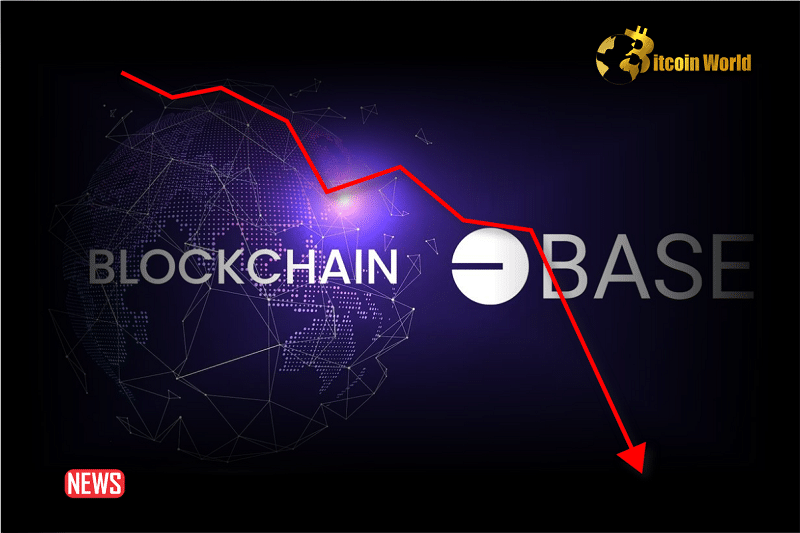Remember when Base burst onto the scene as the hot new Layer 2 blockchain? Fueled by the buzz around friend.tech, it quickly climbed the DeFi ranks. But hold on, the latest data paints a different picture. Has the initial excitement faded, leaving Base to slip down the DeFi ladder? Let’s dive into what’s happening with Base’s Total Value Locked (TVL) and user activity.
Base Falls Out of DeFi Top 10: What’s Going On?
According to DefiLlama, Base has officially dropped out of the top 10 DeFi blockchains by TVL. That’s a significant shift! Currently sitting at the 11th spot, Base’s TVL is around $412 million. This isn’t necessarily a small number, but it marks a noticeable decline from its previous position. This year has seen a consistent downward trend in DeFi activity on Base, leading to this drop in its overall TVL.

But what does a drop in TVL actually mean? In simple terms, TVL represents the total value of crypto assets locked within a blockchain’s DeFi protocols. A falling TVL can indicate several things: less capital is being deployed in DeFi on Base, users might be moving their assets to other chains, or perhaps there’s less overall activity within Base’s DeFi ecosystem.
DEX Volumes Plummeting: A Deeper Dive into Activity
To understand the TVL dip better, let’s look at Decentralized Exchange (DEX) activity, a key indicator of DeFi health. Data from Artemis reveals a concerning trend: the total volume of daily transactions on Base-based DEXes has plummeted by 28% since January 2nd.
Let’s break down the numbers:
- January 2nd: DEX volume on Base reached $33.21 million.
- January 17th: This volume had shrunk to $23.34 million.
This significant decrease in DEX trading volume suggests reduced interest in trading activities within the Base ecosystem. Less trading often translates to less liquidity provision and overall decreased DeFi engagement.
See Also: Ethereum Layer 2 Network Public Goods Network (PGN) Is Closing Down
Is User Activity on Base Also Declining?
It’s not just DeFi metrics that are showing a downturn. Looking at broader user activity across the Base ecosystem, the picture remains consistent – a decline. Data from Artemis highlights a decrease in several key user metrics:
- Unique Wallet Addresses: The daily count of unique wallets actively sending transactions on Base has decreased by 19% since December 23rd. This indicates fewer new or returning users are interacting with the network.
- Daily Transactions: Following the user decline, the number of daily transactions completed on Base has also dwindled by 29% since December 23rd. Fewer users naturally lead to fewer transactions.

These figures paint a clear picture: user engagement across the Base network is decreasing, impacting both DeFi activity and general network usage.
The Friend.tech Factor: Was Base’s Rise Too Reliant on Social Hype?
Let’s rewind to Base’s initial surge in popularity. A significant driver of its early adoption was undoubtedly the decentralized social network, friend.tech. For those unfamiliar, friend.tech allows users to trade “shares” or “keys” of social media personalities, creating a novel intersection of social networking and crypto trading.
Friend.tech became synonymous with Base, attracting a wave of users and transactions to the L2. However, the crypto world is known for its fast-paced trends, and the initial hype around friend.tech appears to be waning.
Data from Dune Analytics confirms this: daily transactions on Base related to friend.tech trades have significantly fallen since September 2023. Specifically, the daily number of addresses buying keys on friend.tech has plummeted by a staggering 99% since October 22nd, 2023.
This dramatic drop in friend.tech activity has had a ripple effect on Base’s overall network metrics. It strongly suggests that Base’s initial growth was heavily dependent on a single, potentially fleeting, application.
See Also: Bitcoin Hash Rate Drops by 34% As Texas’ Temperature Drops Below Zero
Network Fees and Revenue Follow Suit
Unsurprisingly, with declining user activity and transactions, Base’s network fees and revenue have also taken a hit. On January 1st, network fees on Base hit a two-month low of $40,000. Network revenue has also been on a downward trend since the start of the year.
As of January 17th, Base recorded a revenue of $7,000, marking a 33% decrease since January 1st, according to Artemis data. Lower revenue can impact network sustainability and the incentives for validators and developers within the ecosystem.
Looking Ahead: Can Base Revive its DeFi Fortunes?
Base’s recent data points to a challenging period after its initial burst of popularity. The decline in TVL, DEX volumes, user activity, and network revenue raises questions about its future trajectory in the competitive Layer 2 landscape.
While the friend.tech hype may have subsided, Base still possesses strong fundamentals and the backing of Coinbase. To regain momentum and climb back up the DeFi rankings, Base might need to focus on:
- Diversifying its ecosystem: Moving beyond reliance on single applications like friend.tech and fostering a broader range of DeFi projects.
- Attracting new users and developers: Incentivizing development and adoption through grants, partnerships, and community initiatives.
- Highlighting its unique value proposition: Clearly communicating the benefits of building and using DeFi on Base compared to other Layer 2 solutions.
The coming months will be crucial for Base to demonstrate its resilience and ability to adapt in the ever-evolving crypto space. Will it bounce back and reclaim its DeFi prominence, or will it settle into a different position within the Layer 2 ecosystem? Only time will tell.
Disclaimer: The information provided is not trading advice, Bitcoinworld.co.in holds no liability for any investments made based on the information provided on this page. We strongly recommend independent research and/or consultation with a qualified professional before making any investment decisions.



